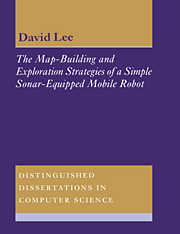 The Map-Building and Exploration Strategies of a Simple Sonar-Equipped Mobile Robot
The Map-Building and Exploration Strategies of a Simple Sonar-Equipped Mobile Robot Published online by Cambridge University Press: 05 March 2012
Chapters 12 to 17 will examine individual exploration strategies and compare their results. This chapter introduces this part of the thesis by examining some general issues which are important whichever strategy is being tested.
Figure 11.1 shows the possible links between exploration algorithms and the rest of the system software. Two extreme types of exploration are represented on the diagram. The top portion of the ‘Explore’ box depicts reactive exploration in which the movement commands are based solely on the most recent sonar readings and the result of the previous command. In contrast, the lower portion depicts exploration which is totally map-driven. The experiments described in this part of the thesis investigate the potential benefits of striking a balance between these two extremes.
What would it mean to say that one exploration strategy is better than another? A reasonable interpretation would be that the first strategy produced a higher quality map than the second, for the same cost of exploration. One then has to decide how to measure the ‘cost of exploration’. Section 11.1 considers some alternatives and selects ‘the total time taken by the robot's movement and sensing actions’.
To make a fair comparison, the strategies must be tested in a variety of circumstances. The effectiveness of a strategy can depend on the environment being explored and on the starting position of the robot within that environment. Each of ARNE's strategies is therefore tested in at least 3 different environments and from 10 starting positions spread throughout each environment.
To save this book to your Kindle, first ensure [email protected] is added to your Approved Personal Document E-mail List under your Personal Document Settings on the Manage Your Content and Devices page of your Amazon account. Then enter the ‘name’ part of your Kindle email address below. Find out more about saving to your Kindle.
Note you can select to save to either the @free.kindle.com or @kindle.com variations. ‘@free.kindle.com’ emails are free but can only be saved to your device when it is connected to wi-fi. ‘@kindle.com’ emails can be delivered even when you are not connected to wi-fi, but note that service fees apply.
Find out more about the Kindle Personal Document Service.
To save content items to your account, please confirm that you agree to abide by our usage policies. If this is the first time you use this feature, you will be asked to authorise Cambridge Core to connect with your account. Find out more about saving content to Dropbox.
To save content items to your account, please confirm that you agree to abide by our usage policies. If this is the first time you use this feature, you will be asked to authorise Cambridge Core to connect with your account. Find out more about saving content to Google Drive.